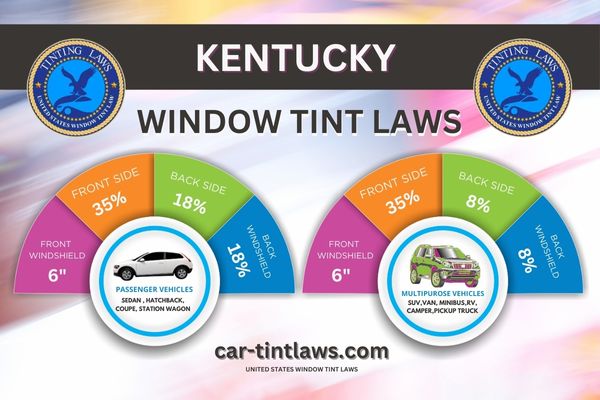When you’re considering window tinting for your vehicle in Kentucky, it’s essential to understand the specific laws that govern how dark or reflective your windows can be.
Kentucky’s regulations differ depending on whether you drive a sedan, SUV, or van, with distinct guidelines on light transmission and reflectivity.
For instance, sedans must have front side windows that allow more than 35% light, while SUVs and vans need at least 32%.
These rules are strictly enforced by the Kentucky State Police, and non-compliance could lead to fines and legal issues.
But what about medical exemptions and other nuances? Let’s explore further.
Window Tint Darkness in Kentucky
In Kentucky, the law specifies different Visible Light Transmission (VLT) limits for sedans, SUVs, and vans to guarantee road safety.
For sedans, the front side windows must allow more light compared to the rear windows, while SUVs and vans have slightly different requirements.
You’ll need to make sure your vehicle’s tint complies with these regulations, keeping in mind the 3 percent tint variance allowed by the state.
Tint darkness for sedans:
- Windshield: Non-reflective tint is allowed on the top 6 inches of the windshield.
- Front Side windows: Must allow more than 35% of light in.
- Back Side windows: Must allow more than 18% of light in.
- Rear Window: Must allow more than 18% of light in.
Tint darkness for SUV and Vans:
- Windshield: Non-reflective tint is allowed on the top 6 inches of the windshield.
- Front Side windows: Must allow more than 32% of light in.
- Back Side windows: VLT of 8%.
- Rear window: Any shade can be used.
Window Tint Reflection in Kentucky
When it comes to window tint reflection in Kentucky, you need to know the specific regulations for different vehicle types.
Sedans must adhere to a 25% reflection limit on front side windows and a 35% limit on back side windows, while SUVs and vans have the same requirements.
Ensuring your vehicle meets these standards is essential to avoid fines and penalties.
Tint reflection for sedans:
- Front Side windows: Must not reflect more than 25% of light.
- Back Side windows: Must not reflect more than 35% of light.
Tint reflection for SUV and vans:
- Front Side windows: Must not be more than 35% reflective.
- Back Side windows: Must not be more than 35% reflective.
Other Kentucky window tint rules and regulations
- Side Mirrors: No restrictions.
- Restricted Colors: In Kentucky, all tint colors are permitted.
- Certificates: Manufacturers of film need to certify the film they sell in the state. Ask your dealer if they are using certified film.
- Stickers: The sticker/label of compliance to identify legal tinting is required between the film & glass on each tinted window.
- Medical Exceptions: Kentucky permits medical exemptions for special tint. For more details about the specific terms of the exemption, consult KY state law.
- Penalties: Violating Kentucky’s tint laws can result in fines. The maximum penalty for a first conviction is $100 and/or 10 days in prison. For a second conviction within a year, the maximum penalty is $200 and/or 30 days in jail. For a third and subsequent offense within a year, the maximum penalty is $500 and/or up to 3 months in prison.

Medical Exemptions for Window Tint Rules in Kentucky
If you have a medical condition that necessitates darker window tint, Kentucky allows for exemptions with the right documentation.
Medical exemptions to the window tint rules in Kentucky are available for individuals with documented medical conditions that require a darker tint.
To obtain one, you’ll need to provide proper documentation from a licensed medical professional.
This documentation must detail the specific medical condition that justifies the use of a darker tint, going beyond the standard Visible Light Transmission (VLT) limits.
It’s crucial to keep this proper documentation in your vehicle at all times.
If law enforcement questions the darkness of your window tint, you’ll need to present this documentation to show that your tint exceeds standard limits for legitimate medical reasons.
Kentucky’s medical exemption guarantees that individuals with medical needs can benefit from darker window tint while still complying with state laws.
Kentucky Window Tint Ticket Cost
Violating Kentucky’s window tint regulations can cost you between $20 and $100 per ticket.
If you’re caught with illegal window tint, these fines can add up quickly, impacting your wallet and potentially your driving record.
Kentucky treats window tint violations as a class B misdemeanor, which means that repeated offenses could lead to more severe legal consequences.
Understanding the specific tint regulations in Kentucky is essential to avoid these fines.
The state has clear guidelines on how dark and reflective your vehicle’s windows can be, and compliance is not just recommended, it’s necessary.
Staying within these legal limits helps you avoid unnecessary penalties and ensures you’re driving safely and legally.
It’s important to note that beyond the immediate financial impact, multiple violations can create a lasting record that might affect your insurance rates and overall driving privileges.
Keeping your vehicle’s window tint within the legal limits ensures you remain in good standing with the law and avoid these costly fines.
Staying informed about Kentucky’s window tint regulations and maintaining compliance will help you prevent any unwelcome legal consequences, allowing you to drive with peace of mind.
Kentucky Demographics Overview
When considering Kentucky’s window tinting laws, understanding the state’s demographic distribution is crucial.
With a population of approximately 4.5 million, Kentucky features a mainly rural landscape, with urban centers like Louisville, Lexington, and Bowling Green.
The state’s racial composition and median age of 39 years old also impact these urban and rural dynamics, providing insights into how window tint regulations might impact various communities.
Population Distribution Insights
Kentucky’s population of around 4.5 million is fairly evenly split between its urban and rural areas.
When you observe Kentucky’s population distribution, you’ll see a balance that mirrors both bustling cities and tranquil countryside.
The largest city, Louisville, boasts over 600,000 residents, making it a hub of activity and diverse demographics.
On the other hand, the state capital, Frankfort, has a smaller population of about 27,000 people, contributing to Kentucky’s unique blend of urban and rural life.
In terms of demographics, Kentucky is mainly White, but significant minority groups like African Americans and Hispanics add to the state’s cultural richness.
Population density varies across the state, with the highest concentrations in urban areas such as Louisville and Lexington, where you’ll find a more crowded, fast-paced environment.
Rural areas, however, offer more space and a slower pace of life, reflecting the state’s diverse character.
Understanding these population distribution insights is crucial for grasping the state’s unique dynamics.
Whether you’re a city dweller or prefer the peace of the countryside, Kentucky’s demographic and population density details paint a detailed picture of its diverse communities.
Urban Vs. Rural Statistics
Understanding Kentucky’s population distribution leads us to explore the distinct urban and rural statistics that shape the state’s demographics.
With around 58% of residents living in rural areas, Kentucky’s rural population is significant.
Urban areas like Louisville and Lexington, however, have higher population densities, offering more job opportunities and better access to amenities such as healthcare and education.
In rural Kentucky, median household incomes and educational attainment levels are generally lower compared to urban areas.
This economic disparity is a key factor in understanding the state’s overall demographic makeup.
Urban residents typically have higher incomes and better access to education and healthcare services, which contributes to a more robust economic environment.
Rural communities often face challenges like limited access to healthcare services and infrastructure, impacting their quality of life.
In contrast, urban areas benefit from more developed infrastructures and greater service accessibility.
This dichotomy affects various aspects of life, including the application of window tint laws.
In urban areas, the need for window tint might relate to the density and proximity of buildings, whereas in rural areas, tinting may be more about privacy and protection from the sun.
Understanding these differences helps in fully grasping Kentucky’s demographic landscape.
Demographic Trends Analysis
With a population of approximately 4.5 million and a median age of 38.9 years,
Kentucky showcases a unique demographic profile. The state is mainly rural, with only two cities exceeding 100,000 residents.
About 86% of the population is White, 8% is Black or African American, and 3% is Hispanic or Latino.
This mix of urban and rural settings impacts the way state law, including the Kentucky Revised Statutes, governs aspects like window tinting.
In Kentucky, window tinting laws are specific and detailed. The Visible Light Transmission percentage, which is the amount of light a window film allows through, is regulated to ensure safety.
For example, windshield tint must allow more light compared to rear side windows.
Compliance with these regulations is vital, and Personal Injury Lawyers often reference state law to determine liability in accidents involving tinted windows.
The median household income in Kentucky is around $52,295, and the poverty rate stands at about 17.2%.
Educational attainment is also notable, with around 87% having a high school diploma and 23% holding a bachelor’s degree or higher.
These demographics can influence how residents adhere to and interpret laws, including those related to window tinting.
References
Kentucky Revised Statutes section 189.110: Unobstructed windshields. (PDF file)
Frequently Asked Questions
What Is the Darkest Legal Tint in Kentucky?
You’re wondering about the darkest legal tint in Kentucky, right? For cars, it’s 18% tint percentage, while trucks and SUVs can go down to 8%.
Considering legal limits, safety concerns, and police enforcement, tint also offers UV protection, heat reduction, and visual appeal.
How Much Is a Tint Ticket in Kentucky?
A tint ticket cost in Kentucky ranges from $20 to $100. Enforcement procedures focus on tint percentage limits.
You might face tint violation consequences, including fines, tint removal process, tint inspection requirements, or seeking tint waiver options.
Is There a Tint Exemption in Kentucky?
Oh, you’re wondering if there’s a tint exemption in Kentucky? Well, if you’ve got a medical reason, your vehicle type can sport darker tints.
Just make sure you’ve got proper exemption details and follow safety regulations. Privacy and UV protection? Covered!
What Is the Tint Law in Kentucky 2024?
In 2024, Kentucky’s tint law requires a minimum tint percentage of 70% for windshields, ensuring vehicle safety.
Side windows need 35%, rear 18%. Tint inspection helps law enforcement, offering UV protection, heat reduction, and addressing privacy concerns.
Conclusion
Understanding Kentucky’s window tinting laws is essential for every driver.
Think of these regulations as the clear lens through which you must view your vehicle’s compliance.
By adhering to specific light transmission and reflection requirements, you avoid penalties and guarantee safety.
Remember, whether you drive a sedan, SUV, or van, these rules keep your journey transparent and lawful. Stay informed, abide by the guidelines, and drive with clarity in Kentucky.
